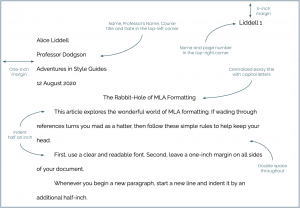How to Format Headers in MLA
- Tomas Elliott (Ph.D.)
- Published on 02/08/2024
Headers are crucial because they help organize your work and provide important information about your paper. In this guide, we’ll walk you through how to format headers in MLA style, with examples to make things crystal clear.
FORMATTING HEADERS IN MLA
- At the beginning of your paper, place the header in the top-left corner of the page, positioned one inch from the top margin of your document. Include the following elements, each on separate lines and double-spaced: your name, your professor’s name, the title and code of your course (if applicable), and the date.
- Headers should be placed in the top right corner of each page. They should be half an inch from the top and aligned with the right margin. The header should contain your last name followed by a space and then the page number. For example, if your last name is Lloyd, the header on the first page of your paper would be: Lloyd 1.
- The font for the header should be the same as the rest of your paper. Typically, MLA format suggests using Times New Roman in size 12.
- Make sure the header is formatted consistently throughout your paper. It should appear on every page, including the first page.
 |
Word Function: Most word processing software, such as Microsoft Word, offers built-in functions to insert headers automatically. Take advantage of these tools to ensure accurate alignment and consistent formatting throughout your document. By using the header feature, you can easily input your last name and page numbers without worrying about manual adjustments. Consistency in Font and Size: Maintain uniformity in font style and size throughout your MLA headers. Choose a clear and legible font, such as Times New Roman or Arial, and stick to the standard font size of 12 points. Consistent font usage ensures readability and cohesion across all pages of your document, reinforcing its professional appearance. |
MLA HEADING START PAGE EXAMPLE
MLA RUNNING HEAD EXAMPLE
GIVE YOUR CITATIONS A BOOST TODAY
Start your TypeCite Boost 3 day free trial today. Then just $4.99 per month to save your citations, organize in projects, and much more.
SIGN UP
